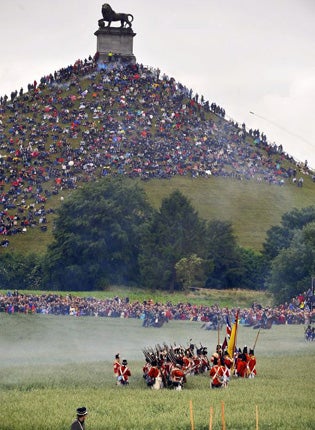Picture of the Day: Once again, Napoleon meets his Waterloo

Your support helps us to tell the story
From reproductive rights to climate change to Big Tech, The Independent is on the ground when the story is developing. Whether it's investigating the financials of Elon Musk's pro-Trump PAC or producing our latest documentary, 'The A Word', which shines a light on the American women fighting for reproductive rights, we know how important it is to parse out the facts from the messaging.
At such a critical moment in US history, we need reporters on the ground. Your donation allows us to keep sending journalists to speak to both sides of the story.
The Independent is trusted by Americans across the entire political spectrum. And unlike many other quality news outlets, we choose not to lock Americans out of our reporting and analysis with paywalls. We believe quality journalism should be available to everyone, paid for by those who can afford it.
Your support makes all the difference.Rifles cracked, artillery thundered and the cavalry charged. Having sent in the Imperial Guard, Napoleon Bonaparte beats a hasty retreat under an onslaught of enemy forces. In a rainswept field in Belgium yesterday, tens of thousands of spectators gathered to watch a recreation of Napoleon's final defeat at the Battle of Waterloo. Around 3,000 historical military enthusiasts from across Europe, armed with heavy guns and supported by 150 cavalry, were willing participants in the reconstruction of five scenes from the battle, which took place 195 years earlier on 18 June 1815.
Fortunately, the re-enactment was not bloody – unlike the original confrontation. Napoleon's Grand Army, numbering 74,000 men and supporting cavalry, faced two forces: the Prussians, commanded by Field Marshal Gebhard von Blücher, and an Anglo-Allied army commanded by the Duke of Wellington. By the end of the day, the French had suffered 7,000 losses and 18,000 were wounded.
The Anglo-Allied toll was 3,500 dead and 11,500 wounded, with 1,300 Prussian dead and nearly 6,000 wounded. The defeat marked the end of Napoleon's military adventures, and the Lion's Mound, an artificial mound on the battlefield site, was built by 1826 to commemorate this key moment in history. But it appears that younger people are struggling to remain interested in the events that shaped Europe for generations. When a young Belgian was interviewed by a TV crew about the battle, he said he thought it had been triggered by "Napoleon and his friends" and that the winners were "the Flemish".
Join our commenting forum
Join thought-provoking conversations, follow other Independent readers and see their replies
Comments